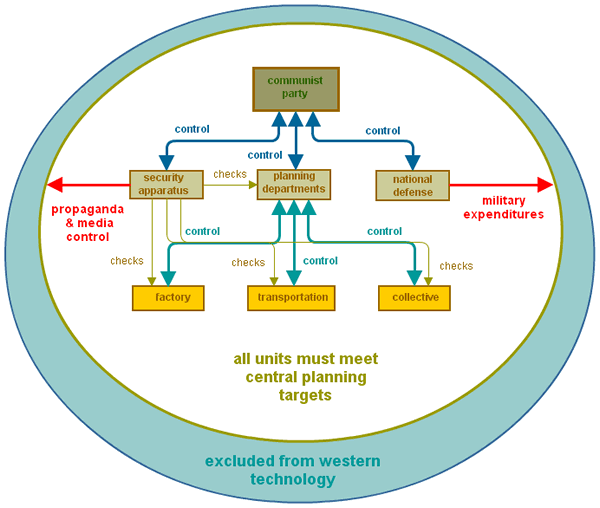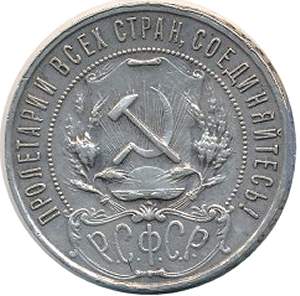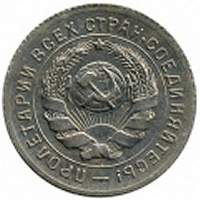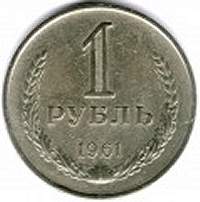Volume Two
Modern States
Communist States: Soviet Union

Soviet Union
The Soviet Union did not become repressive by industrializing: the Bolshevik state was repressive from the first. Lenin seized power in a coup d'état, and added forced labour camps, terror, torture and wholesale murder to the autocratic system he inherited. Perhaps a million people disappeared in these early years of communism: there is little way of knowing for sure. But then few democratic counterweights had existed to government in tsarist Russia. Books and newspapers were strictly censored, and even the educated classes had limited contacts with the common people. The serfs had become land-owning peasants, but were driven just the same by rural backwardness and poverty to the new cities and factories where, denied political expression, they supported a socialist intelligentsia with extremist policies. Worse appeared under Stalin: the 1937-8 Great Terror, the labour camps or gulags whose output became essential to the Soviet state, and collectivisation that led to starvation and destruction of the peasant's way of life, seen by many historians as a catastrophe from which the system never fully recovered. And if desperate measures were born out of the miseries of WWI, they were only intensified in WW II. Troops were stiffened with commissars to prevent desertion, and victories achieved with horrific loss of life. Yet even this truly heroic period — credited to Stalin and unyielding communist principles — was unmasked by Khrushchev's 1956 speech when the reality of Stalin's despotic rule was disclosed, only partially, but sufficient for disillusion to set in. The young turned away from the stern principles and suffering that characterized their parent's and grandparent's lives, and looked to the west for alternatives. The great social experiment was over, and, though the Union was kept together by political and military force for several decades more, its end was inevitable when Gorbachev relaxed that force. {1}
From Imperial Russia to Russian Federation
Economic breakdown, war weariness, and discontent with the autocratic system of government overthrew the tsarist government, but the coalition of liberals and moderate socialists brought to power was itself overthrown by the Bolshevik coup d'état of 25th October 1917. Rule was thenceforth through the communist party, and repression was part of the system, from Lenin to Gorbachev, though most markedly in the Stalin era when the country was brutally industrialized. Economic growth was mixed but by no means unsatisfactory till the 1980s, however, after which all aspects languished until the Gorbachev reforms, which quickly and unintentionally led to the break-up of the Soviet empire. {2}
What remained of the country was inaugurated as the Russian Federation in January 1992, but the country lost its superpower status as satellite states declared their independence. The socialist central planning and state ownership of property was scrapped, and a new economy was built on capitalist principles. Responding to an abortive coup, Boris Yeltsin dissolved the Russian parliament in September 1993, and a new constitution was approved in December 1993, which retained Yeltsin as a dominant figure, though he was barely in control of events that saw nationalized industries given away at fire-sale prices to corrupt oligarchs. Yeltsin resigned at the end of 1999, and Vladimir Putin was named Acting President. In March of the following year, Putin won election in his own right as Russia's second president with 53% of the vote, and moved quickly to reassert Moscow's control. The previous eight years of changes towards a western market economy had been devastating, with the Russian populace suffering as badly as had the Americans in the Great Depression. Putin stopped the spiral of hyperinflation, stabilized the government, and pushed through reforms in banking, labour, and private property. The bloody civil war in Chechnya was brought to an end, and relations with the USA improved after 9/11, when the two countries recognized common terrorist problems. The New START Treaty of 2011 reduced deployable nuclear weapons; the 123 Agreement established a legal framework for joint work on peaceful uses of nuclear energy; NATO, the US and Russia cooperated in common policies towards Afghanistan and Iran. {3}
Early Soviet State
Russia was slow to industrialize, but on the eve of revolution had 71,000 km of railway track, smelters producing 4 million tons of pig iron per year and mills processing almost as much cotton (from Uzbekistan) as Germany. Almost half the population was literate. Private banking was rudimentary, however, and the country relied on foreign capital, funding the railways, for example, by selling securities overseas. The share of heavy industry in Russia's GDP rose from 2% in 1885 to 8% in 1913, but agriculture took the lion's share. The 1917 Revolution was followed by four years of civil war, in which the Bolsheviks had to accept the peasants' demand for ownership and equal division of the land. {4}
The Soviet 'big push' began in 1928 with the first Five Year Plan. Investment was channelled into heavy industry and machinery production. Targets were set, and bank credit extended where necessary. Mass education was enforced and adult education encourage. The fourth pillar was collectivisation, and a disaster: farm output fell, and millions died of starvation in 1933. In other respects the plan succeeded. Pig iron production had expanded to 15 million tons by 1940. Electric power generation had increased from 5 to 42 billion kilowatt-hours. The investment rate rose to 19% of GDP in 1939. In the same year, the USSR processed 900,000 tons of ginned cotton, 50% more than Britain's, though only 52% of America's figure. {4}
Always brutal in his methods, transporting millions to new territories, to slave labour in the gulags, or to their deaths on murderous projects like the White Sea Canal, Stalin strengthened his hold on power through party appointments, informers, an efficient secret police force, swift removal of potential opposition and the 1937-8 reign of terror. Hundreds of thousands perished as the tortured 'named' their fellow conspirators. Illustrious Bolsheviks, fellow colleagues who had made the Revolution, 'confessed' to treasonous crimes in show trials and were executed. The army was purged of its experienced men — 80,000 officers were shot — and so seriously weakened when Germany broke its 1939 Non-Aggression Treaty. Horrific battle losses were slowly reversed, however, and Stalin gradually left the command to professional soldiers. German supply lines were over-extended, and all combatants had then to face the Russian winter. Stalingrad proved a turning point, and by 1944 Soviet armies were recapturing enemy ground and advancing on Germany allies. {5}
WWII brought had unmitigated hardship nonetheless. 15% of citizens lost their lives (40% in the 20-49 age group), and wide swathes of farms and industry were devastated. Nonetheless, much had been repaired by 1950, and by 1975, the USSR's steel production of 100 million tons exceeded that of the USA. Investment was kept at 38% of GDP, the fertility rate dropped, and more consumer goods were produced. {6}
Progress was gradually lost in the 1970s and 80s, however, for reasons still debated, but probably involving a lack of:
Proper incentives: the cradle to grave care supported everyone regardless of talent or effort.
Sufficient human rights: citizens were given free education, free health care and work but not the freedom to criticize the system.
Accountability: management became increasingly bureaucratic and divorced from everyday needs.
Alternatives: citizens were kept ignorant of more successful political and economic models. {7}

Equally important after 1945, however, were:
A ban on transfer of technology to the USSR.
Trade embargoes on USSR goods.
Diversion of economic effort to the arms race.
Corruption and loss of vision by the centralizing bureaucracy.
Excessive development of Siberia.
A rigid administration overwhelmed by the needs of a modern society.
Disillusion as Stalin's actions became better known through Kruschev's speech and some lifting of censorship.
A loss of creativity: lacking competition, superseded technologies were kept longer on than was the case in the west. {7}
End of the Soviet Regime
The change from a communist centrally-planned economy to one market-led was extremely traumatic, and saw all the worst excesses of local corruption and western financial plunder. Under Washington-led gurus, large sectors were privatised to oligarchs, who also became politically important in former Soviet satellites. Economic problems of the 1990s included difficulties in raising government revenues, a dependence on short-term borrowing to finance budget deficits, lower prices for its oil and mineral exports, and capital flight exacerbated by the Asian crisis. The rouble declined 60% in value, foreign investment left the country, payments on private and sovereign debt were delayed and the commercial banking system broke down. The economy recovered quickly from the 1998 crisis, however, and achieved 9 years of sustained growth averaging some 7%/year, a success helped by a devalued rouble, reform in tax, banking, labour and land codes, a tight fiscal policy, and favourable commodities prices. Household consumption and capital investments both grew by some 10%/year, and replaced net exports as the main drivers of demand. Foreign exchange reserves had grown to almost $600 bn by mid-2008, the third largest in the world. The country repaid its entire Soviet-era Paris Club debt of $22 billion in late 2006, but by October 2008 had foreign external debts of $540 billion, of which $500 billion was owed by banks and corporations, including state-owned enterprises. {8}
Soviet Life
The drabness of Soviet life is reflected in its coinage. Leaving aside the commemorative pieces, not devoid of propaganda but often better designed, the circulation coinage was strictly utilitarian, and seems as soulless and unimaginative as the cities of Soviet central Asia. The same images, the same styles and the same slogans appear, year after year, and though there are series that last a decade or so, the design changes do not correspond with major changes in leadership or social events. Indeed the coins were practically coupons. Wages were fixed, and covered the basic necessities of life. There was little choice between generally badly manufactured goods, and money could not be exported. {9}
Coinage of the Revolution
Revolution was probably inevitable by 1917. W.W.I. brought down the German and Austro-Hungarian Empires, and the Czarist Empire was even less able to supply weapons to its soldiers or feed its people. Under Lenin, the Bolsheviks were united, committed and ruthless, and an immiserated society had been too brutalized by war and economic mismanagement to accept the half measures of the Kerensky government. Only a new world order that saw the total overthrow of existing institutions met their strident needs, and while the peasants in particular did not like the Red Army, the White Armies were just as brutal, and offered only a return to the past. {10}
 | Soviet Union Ar One Ruble 1921-2 issue.. 90% silver 20 g 33.5 mm. Obverse: five-pointed star bearing figure 1 and surrounded by oak wreath. 1922 below. |
 | Reverse: hammer and sickle with ears of corn. Legend around is 'ПРОЛЕТАРИИ ВСЕХ СТРАН, СОЕДИНЯЙТЕСЬ! (Workers of the world, unite!) Edge description is 'ЧИСТОГО СЕРЕБРА 4 ЗОЛОТНИКА 21 ДОЛЯ (A.Г) (Krause Y# 84) |
Civil war, famine and population depletions had weakened the Party leadership, which was obliged to accept some return to private enterprise and ownership in the New Economic Policy of 1921-28. {6} Though agricultural produce increased under the NEP, Stalin introduced collectivisation and 5-year plans of rapid industrialization nonetheless, which led to the Holodomor, the 1932-3 Ukrainian famine that killed upwards of 2.5 million. {7} Then followed the 1936-8 Great Purge, perhaps also instigated to remove opposition to Stalin and his policies, in which another 0.6 to 1.2 million perished. {10}
 | Soviet Union Cu-Ni 10 kopecks 1931-34 issue. 17.27 mm 1.8 g. Obverse: worker holding shield with denomination, surrounded by legend 'СOЮ3 СOBETCKИX СOЦИAЛИCTИЧECKИX РECПУБЛИK' (Union of Soviet Socialist Republics) 1931 above. | |
 |
|
Repression left the USSR ill-equipped to fight the Nazi invasion, and some 27 m. Russians indeed died in W.W.II, incomparably more than European or American fatalities. {9} Repression continued after Stalin's death in 1953. Gulags and arbitrary arrest were a feature of Soviet life throughout, up to and including the early Gorbachev years. {10} Given these horrors, the average citizen did not aspire to material betterment or intellectual independence — bourgeois sentiments — but, like the peasant, simply to stay alive. {10}
 | Soviet Union Cu-Ni-Zn 1 ruble 1961-91 issue. 27 mm 7.5 g. Obverse: 1 ruble enclosed by wheat wreath. 1961 below. |
 | Reverse: globe bearing hammer and sickle, surrounded by bound wreaths of wheat and then legend 'СOЮ3 СOBETCKИX СOЦИAЛИCTИЧECKИX РECПУБЛИK' (Union of Soviet Socialist Republics) (Krause Y# 134a.1) |
Coinage is an art, assuredly a minor art, but still one expressive of the human spirit, its aspirations and its freedoms. Everything in the USSR was harnessed to the will of the people, though, and, however noble that sounded, in practice the doctrine amounted to control by a narrow-minded bureaucracy. The October Revolution had severed Russia from her European neighbours, and a rigid censorship was soon imposed, banning non-political and trivial genres like romance, mystery and detective stories.{11}
A dead level of uniformity was expected, and experimental western ideas eliminated. Even international stars like Prokofiev, Shostakovitch,{13} Gorky and Pasternak were greatly restricted in what they could do, and countless lesser names were suppressed altogether. Many disappeared in the Great Purges: Meyerhold, Mandelshtam, Babel, Pilnyak, Yashvili, Tabidze, Mirsky, Averbakh . . a long list. {11}
 |  |  |
 |  |  |
Soviet Union Au 10 rubles 1921-23 issue. 22 mm 8.6 g. Obverse: worker sowing the fields. ОДИН червонец 1923 (One Ducat 1923) Edge description 'ЧИСТОГО ЗОЛОТА 1 ЗОЛОТНИК 78,24 ДОЛИ (П.Л)'. Reverse: globe bearing hammer and sickle, surrounded by wreaths of wheat and then legend ' 'ПРОЛЕТАРИИ ВСЕХ СТРАН, СОЕДИНЯЙТЕСЬ! (Workers of the world, unite!). | Soviet Union Cu-Ni-Zn 20 Kopecks Commemorative 1967 issue to mark 50th anniversary of the Revolution. 21.8 mm 3.4 g. Obverse: globe bearing hammer and sickle, surrounded by bound wreaths of wheat. ПЯTbECЯT ЛЕТ COBETCKOИ BЛACTN (fifty years of soviet power) Reverse: 20 kopecks above stylized view of industrial works.(Krause # 138) | Soviet Union Cu-Ni 1 ruble. Commemorative 1980 issue to mark Moscow Olympic games. 31 mm 12.8 g. Obverse: hand bearing Olympic flame with view of stadia behind. Legend is ИГPbI XXII ОДИН РУБЛЬ MOSKBA 1980. (IGPbI 22. One Ruble Moscow 1980) Reverse: globe bearing hammer and sickle, surrounded by bound wreaths of wheat CCCR (Union of Soviet Socialist Republics) 1 ruble below in exergue. (Krause # 178) |
Many of the pieces shown here, particularly the commemorative pieces, are not unattractive, and contemporary issues, like those of communist China, can be very highly finished indeed. Even the 10 kopecks coin illustrated above is surely appropriate, denoting honest craftsmanship on the obverse, and the hopes of international communism on the reverse — no more assertive in its slogan (Workers of the world, unite!) than the power denoted by the bald eagle on the American dollar. {11}
Yet the later pieces seem more mechanical, which is only to be expected when the communist system no longer reflected or engaged with the deepest wishes of its peoples. {11}
2008 Financial Crash
The global economic crisis hit Russia hard. Capital flight in September 2008 caused a crisis in its stock market, one not helped by business disputes like TNK-BP and Mechel, and the Georgian war. The market collapsed in mid September as businesses sold shares to raise collateral for margin calls required by international lending institutions. GDP growth ground almost to a halt in the fourth quarter of 2008, down to 1.1% (from 9.5% during the same period in 2007). The Central Bank of Russia averted a banking crisis by pumping liquidity into Russian banks, and staging a managed devaluation, one which avoided bank runs but reduced foreign exchange reserves to $387 billion in mid February 2009. This prompted the S&P and Fitch rating agencies to downgrade Russia's sovereign debt to the lowest investment grade. {12}
By 2010, however, the Russian economy had begun a modest recovery, bolstered by government policies and a rise in oil prices. Renewed emphasis was placed on innovation, modernization and diversification away from dependence on oil and gas. {9}
Nonetheless, tighter credit, collapsing global demand, global uncertainty, and rising unemployment hurt investment and consumption, leading to a -7.9% GDP growth in 2009, a striking contrast to the pre-crisis performance of 8.1% in 2007. Russia returned to growth with a 4.2% increase in GDP in 2010, the third highest growth rate among the world's leading economies, and the government prediction was for 3.7% growth in 2012. Growth in fact was 3.5%, though higher rates were predicted for 2013 and beyond. {13}
Russia has now been hit by sanctions and a lowered oil price, but was enjoying a stable market-based economy in 2013, giving it the thirteenth largest GDP in the world. Some 10% of the population worked on the land (accounting for 5% of GDP), and agricultural reforms had turned the country into a grain exporter. Some 32% worked in the industrial sector (accounting for 34.8% of GDP) and, of these a fifth were in the armaments sector, making Russia the second-largest conventional arm exporter. The service industries accounted for 58% of GDP, employing 45 million people in retail, tourism and advertising. Unemployment was still high, as was the percentage below the poverty line: some 11 million people lacked a proper source of income. Press freedom was and is still limited. Russia joined the World Trade Organization in 2012, reducing trade barriers and helping to open foreign markets for Russian goods. 2014-5 events in the Ukraine have been contentious, the mainstream western press demonising Putin for old Soviet-style aggression, and the alternative press regarding him as legitimately defending Russian interests. {14}
China
 China, Japan and surrounding countries were largely self-sufficient until late into the nineteenth century. Defeat in the 1840-2 Opium War damaged the prestige of the Qing Dynasty, however, and belief in its centralized bureaucratic monarchy, the patriarchal family and the scholar-official elite were shattered by civil wars. The 1850-64 Taiping Rebellion alone claimed 20 million lives, and a 20,000-strong European army invaded and looted Peking in the 1900 Boxer Rebellion. In contrast to Japan under the (1868-1905) Meiji emperor, China only reluctantly looked abroad, and indeed had its own commercial and industrial history to call on. Some historians believe it was only the lack of cheap coal — the mines were small and distant — that prevented industrialization in the (1368-1644) Ming or even (960-1279) Song Dynasties. Generally, moreover, governments allowed commerce a free hand, and by Song times China had developed many of the commercial institutions needed for modern trade and industry, including cheques, paper money and state investment. {15}
China, Japan and surrounding countries were largely self-sufficient until late into the nineteenth century. Defeat in the 1840-2 Opium War damaged the prestige of the Qing Dynasty, however, and belief in its centralized bureaucratic monarchy, the patriarchal family and the scholar-official elite were shattered by civil wars. The 1850-64 Taiping Rebellion alone claimed 20 million lives, and a 20,000-strong European army invaded and looted Peking in the 1900 Boxer Rebellion. In contrast to Japan under the (1868-1905) Meiji emperor, China only reluctantly looked abroad, and indeed had its own commercial and industrial history to call on. Some historians believe it was only the lack of cheap coal — the mines were small and distant — that prevented industrialization in the (1368-1644) Ming or even (960-1279) Song Dynasties. Generally, moreover, governments allowed commerce a free hand, and by Song times China had developed many of the commercial institutions needed for modern trade and industry, including cheques, paper money and state investment. {15}
By the 1860s the government was building factories and dockyards, and in 1880 China had legations in London, Paris, Berlin, Madrid and Washington. Li Hongzhang, a minister at the Peking court, helped set up the China Merchants' Steam Navigation Company (1972), the Kaiping coal mines (1877), a telegraph company (1879), a cotton spinning factory (1882) and a cotton weaving mill (1890). Railways were laid and the Hayang Iron Works opened at Wuhan in 1890. Progress was slow, however, hampered by a conservative court, the xenophobia of local peoples and the absence of tariffs to protect fledgling industries. Wages stayed low, indeed decreased as the population increase split farms into smaller, hardly sustainable sizes. Nonetheless, agricultural improvements were made: more land was cleared, irrigation improved, fertilizers used and new crops like maize and sweet potatoes introduced. Women worked in the fields, though female infanticide reduced their numbers and encouraged young men to leave the land. They found manual jobs in cities, and emigrated in their millions to Australia, the Americas and surrounding southeast Asia countries. The tin mines of the British-controlled Malaysia were a favoured destination, but hundreds of thousands also signed up to work in the mines and plantations of Cuba, Peru, Hawaii and Sumatra. {15}
The Japanese threat increased the need for modernization: the Ryakyu islands were ceded to Japan in the 1870s, and then Liadong and Taiwan. China indeed had to pay an 'indemnity' of 200 million ounces of silver, and allow Japan to open factories in China. The European powers were just as grasping. Germany seized Jiaozhou in Shandong, Russia got Liaodong, Britain Weihaiwei and the New Territories near Hong Kong. {15}
For all their intelligence, the scholar-official class were not trained in market economics. Nor had the revolution leaders the necessary vision to revitalize China, and though merchants made fortunes in the treaty ports they did not hand the benefits on to the population at large. {15}
The Qing dynasty was overthrown in 1911, but the country was fragmented between warlords and imperialist powers. The Nationalists gained control in 1927 when Jiang Jieshi turned on his communist collaborators, but the war continued, against the communists and invading Japanese. The country was modernizing in the towns with electricity and western life styles, but remained the same if not worse in the countryside, from which the Communists drew their greatest support. The Shanghai of 1930 had some 170,000 women working in mills and factories, and some 50,000 still as prostitutes and a similar number as household servants. The Japanese took Nanking in 1937, with horrific massacres, and though free China retreated inland and held 60% of China's population, the area contained only 5% of its industry. Attempts to build a new industrial base by thwarted by constant Japanese bombing. Struggles between the Nationalists and Communists intensified after the Japanese were defeated in W.W.II, but the Communists led by Mao Zedong (1893-1976) proved finally victorious. Mao was an astute political operator, and kept the Communists closer to the peasants, who were promised radical improvements. {15}
Mao's record is a mixed one. A fairer, communist system was indeed instigated, land was redistributed, heavy industry expanded, Chinese sent for training in the USSR and Soviet technicians imported. The Korean war ended in stalemate, and China regained respect on the world stage. But the regime was oppressive. The country was purged of old ideas, and some tens or hundreds of former Nationalists executed in 1951. Agricultural collectives were amalgamated into gigantic communes in the 1957-8 'Great Leap Forward', and bridges, railroads, canals, reservoirs, power stations, mines and irrigation works successfully constructed, but in the 'hard years' of 1959-62 some thirty million starved to death. The Cultural Revolution of 1966, where the young criticized and sometimes murdered intellectuals and former party members, got out of hand, requiring the Red Guard to be disbanded and sent to work in the countryside. Bizarre plots against Mao were 'uncovered', and the great leader gradually retired from public life. Deng Xiaoping was rehabiliated in 1973, and again in 1978, after Mao's death. His reforms had tripled average incomes by the early 1990s and lifted 170 million peasants out of extreme poverty. {15}
References and Further Reading
Need the 85 references and 9 illustration sources? Please consider the inexpensive ebook.
